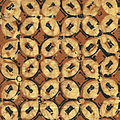Batik
Batik is an Indonesian method of dyeing cloth and making it resistant using wax. Such fabrics originally come from the island of Java. Nowadays, batik also can be found worldwide, mainly in Asia and Africa.
| Batik | |
|---|---|
 | |
| Country | Indonesia |
| Domains | Traditional craftsmanship, oral traditions and expressions, social practices, rituals and festive events |
| Reference | 170 |
| Region | Asia and the Pacific |
| Inscription history | |
| Inscription | 2009 (4th session) |
| List | Representative List |
 Written batik (batik tulis) and stamped batik (batik cap) | |
| Education and Training in Batik | |
|---|---|
 | |
| Country | Indonesia |
| Domains | Traditional craftsmanship, oral traditions and expressions, social practices, rituals and festive events |
| Reference | 318 |
| Region | Asia and the Pacific |
| Inscription history | |
| Inscription | 2009 (4th session) |
| List | Register of Good Safeguarding Practices |
 Education and training in Indonesian Batik intangible cultural heritage for elementary, junior, senior, vocational school and polytechnic students, in collaboration with the Batik Museum in Pekalongan | |

History of batik
Batik is an ancient fabric wax-resist dyeing tradition of Java island (nowadays part of modern Indonesia).[1] In the Ramayana—ancient Sanskrit epics dated 500 BC—, the island of Java is recorded as the island that already had seven kingdoms long before the story of Ramayana created, and Batik is one of the regarded clothes that have glorious value that originally made by the manufacturers within the kingdoms' environment itself.[2] Batik is a part of an ancient Javanese tradition and has been taught for centuries, the art of batik is most highly developed in Java and some of the best batiks in the world still made there until today.[3]
Due to the colonialism, batik also became popular in the Western countries, especially since the Dutch colonial era.[4]

Technique
To make a batik, they use the cloth as the paper, and they just start drawing hot wax over the cloth. And they said if we repeated the process, it will be more colorful. For the first step, make sure the cloth is washed. Batik[5] patterns are drawn with pencil and later drawn again using a hot wax. The very common thing that people use is the pen-like instrument called a tjanting. After the cloth is dry, the areas keep their original color, and it also shows the pattern between the areas that have the color and do not have the color. It gives them a pattern. Then the artist repeats the process once for each color. A very traditional type of batik, called written batik, is drawn using only a tjanting. The cloth needs to be drawn on both sides and put in a color bath three or four times. The process may take up to a year.
References
- ↑ "What is Batik?". The Batik Guild. Retrieved 27 November 2020.
- ↑ History of Ancient India Kapur, Kamlesh
- ↑ "Batik in Java". The Batik Guild. Retrieved 29 April 2014.
- ↑ Raffles, Thomas E.: " The History of Java"
- ↑
Batik Media
Kawung batik motif on Mahakala statue, from temple at Singhasari, East Java, Indonesia 12th-century
Clothing detail of 13th-century East Javanese Prajnaparamita statue, National Museum of Indonesia, Jakarta
Principle of resist dyeing used in batik: a wax negative is created, enabling an area of any desired shape to be coloured.
"Batik Technique". Dharma Trading. Retrieved 2016-06-01.











